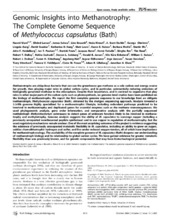Genomic Insights into Methanotrophy: The Complete Genome Sequence of Methylococcus capsulatus (Bath)
Ward, Naomi; Larsen, Øivind; Sakwa, James; Bruseth, Live; Khouri, Hoda; Durkin, A. Scott; Dimitrov, George; Jiang, Lingxia; Scanlan, David; Kang, Katherine H.; Lewis, Matt; Nelson, Karen E.; Methé, Barbara; Wu, Martin; Heidelberg, John F.; Paulsen, Ian T.; Fouts, Derrick; Ravel, Jacques; Tettelin, Hervé; Ren, Qinghu; Read, Tim; DeBoy, Robert T.; Seshadri, Rekha; Salzberg, Steven L.; Jensen, Harald B.; Birkeland, Nils-Kåre; Nelson, William C.; Dodson, Robert J.; Grindhaug, Svenn Helge; Holt, Ingeborg; Eidhammer, Ingvar; Jonassen, Inge; Vanaken, Susan; Utterback, Terry; Feldblyum, Tamara V.; Fraser, Claire M.; Lillehaug, Johan; Eisen, Jonathan A.
Peer reviewed, Journal article
Permanent lenke
https://hdl.handle.net/1956/1966Utgivelsesdato
2004-09-21Metadata
Vis full innførselSamlinger
Originalversjon
https://doi.org/10.1371/journal.pbio.0020303Sammendrag
Methanotrophs are ubiquitous bacteria that can use the greenhouse gas methane as a sole carbon and energy source for growth, thus playing major roles in global carbon cycles, and in particular, substantially reducing emissions of biologically generated methane to the atmosphere. Despite their importance, and in contrast to organisms that play roles in other major parts of the carbon cycle such as photosynthesis, no genome-level studies have been published on the biology of methanotrophs. We report the first complete genome sequence to our knowledge from an obligate methanotroph, Methylococcus capsulatus (Bath), obtained by the shotgun sequencing approach. Analysis revealed a 3.3-Mb genome highly specialized for a methanotrophic lifestyle, including redundant pathways predicted to be involved in methanotrophy and duplicated genes for essential enzymes such as the methane monooxygenases. We used phylogenomic analysis, gene order information, and comparative analysis with the partially sequenced methylotroph Methylobacterium extorquens to detect genes of unknown function likely to be involved in methanotrophy and methylotrophy. Genome analysis suggests the ability of M. capsulatus to scavenge copper (including a previously unreported nonribosomal peptide synthetase) and to use copper in regulation of methanotrophy, but the exact regulatory mechanisms remain unclear. One of the most surprising outcomes of the project is evidence suggesting the existence of previously unsuspected metabolic flexibility in M. capsulatus, including an ability to grow on sugars, oxidize chemolithotrophic hydrogen and sulfur, and live under reduced oxygen tension, all of which have implications for methanotroph ecology. The availability of the complete genome of M. capsulatus (Bath) deepens our understanding of methanotroph biology and its relationship to global carbon cycles. We have gained evidence for greater metabolic flexibility than was previously known, and for genetic components that may have biotechnological potential.
